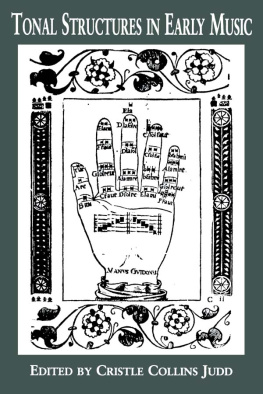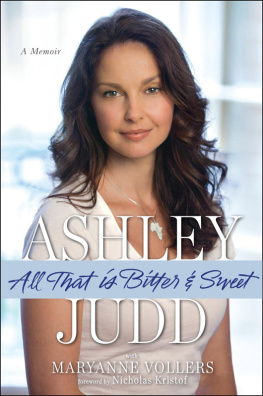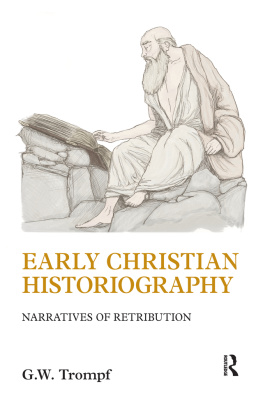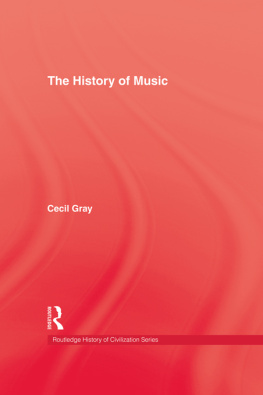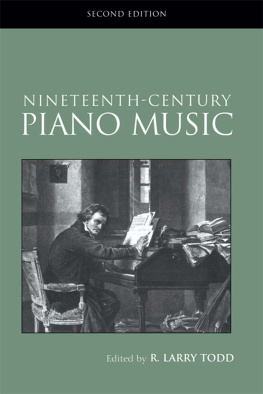Judd - Tonal Structures in Early Music.
Here you can read online Judd - Tonal Structures in Early Music. full text of the book (entire story) in english for free. Download pdf and epub, get meaning, cover and reviews about this ebook. City: Hoboken, year: 2014, publisher: Taylor and Francis, genre: Home and family. Description of the work, (preface) as well as reviews are available. Best literature library LitArk.com created for fans of good reading and offers a wide selection of genres:
Romance novel
Science fiction
Adventure
Detective
Science
History
Home and family
Prose
Art
Politics
Computer
Non-fiction
Religion
Business
Children
Humor
Choose a favorite category and find really read worthwhile books. Enjoy immersion in the world of imagination, feel the emotions of the characters or learn something new for yourself, make an fascinating discovery.
- Book:Tonal Structures in Early Music.
- Author:
- Publisher:Taylor and Francis
- Genre:
- Year:2014
- City:Hoboken
- Rating:4 / 5
- Favourites:Add to favourites
- Your mark:
- 80
- 1
- 2
- 3
- 4
- 5
Tonal Structures in Early Music.: summary, description and annotation
We offer to read an annotation, description, summary or preface (depends on what the author of the book "Tonal Structures in Early Music." wrote himself). If you haven't found the necessary information about the book — write in the comments, we will try to find it.
Judd: author's other books
Who wrote Tonal Structures in Early Music.? Find out the surname, the name of the author of the book and a list of all author's works by series.
Tonal Structures in Early Music. — read online for free the complete book (whole text) full work
Below is the text of the book, divided by pages. System saving the place of the last page read, allows you to conveniently read the book "Tonal Structures in Early Music." online for free, without having to search again every time where you left off. Put a bookmark, and you can go to the page where you finished reading at any time.
Font size:
Interval:
Bookmark:
CRITICISM AND ANALYSIS OF EARLY MUSIC
VOLUME 1
GARLAND REFERENCE LIBRARY OF THE HUMANITIES
VOLUME 1998
JESSIE ANN OWENS, Series Editor
TONAL STRUCTURES
IN EARLY MUSIC
edited by Cristle Collins Judd
COUNTERPOINT AND
COMPOSITIONAL PROCESS
IN THE TIME OF DUFAY
Perspectives from German
Musicology
edited and translated by
Kevin N. Moll
TONAL STRUCTURES IN EARLY MUSIC
EDITED BY
CRISTLE COLLINS JUDD

First published 1998 by Garland Publishing Inc
Published 2014 by Routledge
2 Park Square, Milton Park, Abingdon, Oxon OX14 4RN
711 Third Avenue, New York, NY 10017
Routledge is an imprint of the Taylor & Francis Group, an informa business
Copyright 2000, 1998 by Cristle Collins Judd
All rights reserved. No part of this book may be reprinted or reproduced or utilized in any form or by any electronic, mechanical, or other means, now known or hereafter invented, including photocopying and recording, or in any information storage or retrieval system, without permission in writing from the publishers.
Library of Congress Cataloging- in-Publication Data
Tonal structures in early music / edited by Cristle Collins Judd.
p. cm. (Criticism and analysis of early music; v. 1)
(Garland reference library of the humanities; v. 1998)
Includes bibliographical references and index.
ISBN 0-8153-3638-1 (alk. paper)
ISBN 978-0-815-32388-4 (hbk)
1. Tonality. 2. Musical analysis. 3. MusicTheory. 4. Style, Musical. I. Judd, Cristle Collins. II. Series. III. Series: Garland reference library of the humanities; vol. 1998.
ML3811.T66 1998
781.25809dc21 | 97-49499 CIP MN |
Cover illustration: Angelo da Picitono. Fior angelico di musica.
Venice, 1547, f. Ciir. By permission of the Music Division of the Library of Congress.
Harold Powers
Cristle Collins Judd
Margaret Bent
Sarah Fulle
Frans Wiering
Cristle Collins Judd
Timothy H. Steele
Jessie Ann Owens
Candace Bailey
Harold Powers
Michael Dodds
Jessie Ann Owens
Recent years have seen a critical reassessment of our approach to early music. Musicians, scholars, and critics have been searching for ways of talking about and reacting to the music that engage it not from the perspectives of later music but rather on its own terms. These new approaches would not be possible without the scholarship of the previous decades. The discovery and cataloguing of musical sources, the preparation of critical editions, and the investigation of archival documents have furnished important information about composers, performers, patrons, and institutions that supported the creation and performance of early music. Building on this work, the editors of these volumes now seek to develop and explore analytical methodologies for the discussion of early music as music.
Analytic methods are not easily found for early music. The theorists of the time had their own agendas, and they do not provide models that suit our purposes. As a consequence, many twentieth-century scholars have chosen approaches that reflect their own beliefs about early music and its relation to later music. While some continue to rely on common practice tonality as a prism through which to view early music, others have begun to explore methods that respect the integrity and self-sufficiency of the languages of early music.
We offer a forum for exploration of particular topics, from both a methodological and critical viewpoint. Our premise is that we can best develop new methodologies by encouraging debate. We will explore compositional procedures, tonal structures, musical borrowing, and other topics, focusing both on individual compositions and on theoretical systems. We seek to encourage critical writing about music that will be useful to performers, listeners, and scholars.
Brandeis University
I gratefully acknowledge the support of the University of Pennsylvania in the preparation of this volume. The Music Department underwrote the conference that preceded this book in March 1996 and the University of Pennsylvania Research Foundation provided a publication subvention for the preparation of camera-ready copy. My colleagues Lawrence Bernstein, Christopher Hasty, Norman Smith, and Gary Tomlinson chaired sessions, advised on conference matters, and read preliminary drafts of essays. As both colleague and husband, Robert Judd did all this and more. The graduate students in my Analysis of Early Music seminar provided help in hosting the conference. In addition, I would like to acknowledge Jessie Ann Owens and Harold Powers, participants with me in the roundtable that concluded the conference, and Leeman Perkins, a session respondent, for their generous and practical advice. Thanks are also due to Jessie, not only for inviting me to edit this volume, but also for her unswerving encouragement during the process of preparing it. Sue Cole offered support in matters many and sundry. Regina Christian assisted with page layout and formatting, David Osbon prepared camera-ready copy of music examples in SCORE, and Scot Grogan assisted in proofing and indexing. Ann Dixon and Jay Treat of Educational Technology Services at Penn provided advice on numerous technical matters. I owe a special word of thanks to Richard Hoffman for his invaluable (and good-humored) close reading of the entire manuscript in the final stages of production.
Cristle Collins Judd
Analyzing early music is a venture with a rich history of provoking spirited exchanges within the musicological community. Articulating the problems associated with analyzing early music while proposing new analytical methods and techniques, as the present volume aims to do, brings a number of previously unstated assumptions about the activity of music analysis to the fore and highlights its place in intellectual inquiry. Exploring less conventional methods of analysis while reexamining the relevance of more traditional analytical approaches subjects many currently accepted views of the role of analysis to scrutiny and opens the possibility that analysis can critique and affect established ways of practicing musicology.
The formulation early music analysis captures the difficulties of the enterprise in its inherent ambiguities. Does early modify the activity of music[al] analysis, suggesting a search for historical precedents? Or does the phrase perhaps suggest an addition (and implicit corrective) to tonal and post-tonal analysisthe concerns of much present-day music theory and analysis? Neither emphasis is as straightforward as might at first seem and each is contingent on the other for an understanding of its meaning.
The former understandingearly music analysisdraws into question the ways in which musical analysis is defined and the ways in which we read theoretical and musical texts. Ian Bent has suggested that while analysis as an approach and method can be traced back to the 1750s [i]t existed as a scholarly tool, albeit an auxiliary one, from the Middle Ages onwards.and philosophical strands of rhetoric, but also individual contexts that may impinge on the imputed analytic activity of the theorist in question. Theorists citations of musical examples, if anything, prove even more resistant than the texts in which they are situated to yielding an obvious analytical context or model. When considered as appropriated texts, such examples inclusion in a treatise may just as easily represent an unstated political or social agenda as an overt, if merely secondary, analytical activity. Then there is the problematic issue of how a modern reader is to negotiate the chasm between our world and theirs in using theoretical sources as a model for analytical activity while avoiding the pitfalls of the authentic anachronism.
Font size:
Interval:
Bookmark:
Similar books «Tonal Structures in Early Music.»
Look at similar books to Tonal Structures in Early Music.. We have selected literature similar in name and meaning in the hope of providing readers with more options to find new, interesting, not yet read works.
Discussion, reviews of the book Tonal Structures in Early Music. and just readers' own opinions. Leave your comments, write what you think about the work, its meaning or the main characters. Specify what exactly you liked and what you didn't like, and why you think so.

